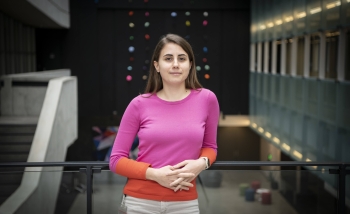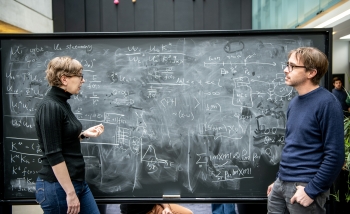Pedro Vieira uses computers to aid in physics calculations – specifically, in the kind of calculations that don’t involve numbers.
It sounds like a paradox – calculations without numbers – but it’s not. Physicists often have a mathematical model and want to understand its behaviour better. The gold standard in physics is to take the analytical (as opposed to the numerical) approach: using mathematical techniques to derive the solution. For example, deriving Kepler’s laws of planetary motion from Newton’s law of gravitation is an analytical exercise: at no point do you need to know the mass or speed or distance of any particular planet. You can create a set of equations that describe any orbit, using only mathematical tools.
But what happens when the mathematics becomes so complex that even all the chalkboards at Perimeter can’t contain it? This is the realm in which Pedro Vieira works.
Vieira is on a quest to find exact, or analytical, solutions in four-dimensional quantum field theory. This challenge has bedevilled researchers since the 1970s, and is probably the toughest and longest-standing set of problems in the field.
Vieira was still a PhD student when he and collaborators found the very first exact solution to a 4D quantum field theory. It was such an outstanding breakthrough, from a young person with such clear promise, that Perimeter made an almost unheard of move: offering Vieira a faculty position straight out of his PhD program.
That was six years ago, and it’s certainly paid off. Vieira has made tremendous scientific progress toward a richer conceptual and practical understanding of 4D quantum field theory, which is the language in which particle physics, condensed matter physics, and much of cosmology is written. In recognition of his work, he’s won a Sloan Research Fellowship and a Gribov Medal – top awards for young researchers.
Here at Perimeter, Vieira was recently appointed the Clay Riddell Paul Dirac Chair in Theoretical Physics. (Its namesake, Paul Dirac, was a remarkable young physicist who developed some of the first working laws of quantum mechanics.) The new chair has been generously funded by the Riddell Family Charitable Foundation, based in Calgary.
As Chair, Vieira is continuing a years-long effort to equip other young researchers with the tools to pursue analytical work. Like many physicists, Vieira uses software called Mathematica to streamline and organize his calculations. It still requires both mathematical talent and physical insight to follow the flow of ideas up and down the dimensions and through the different theoretical lenses, but Mathematica keeps the tremendously long calculations from tangling up, preventing near-inevitable human error. For a certain brand of theoretical physicist, learning to use a tool like Mathematica is an essential, career-changing skill, yet it’s not widely taught. Young physicists are largely left to pick it up as they go along.
Vieira set out to change that. While still a student in Portugal, he founded the Mathematica Summer School on Theoretical Physics. When Perimeter offered him a position, it also agreed to sponsor and nurture the school. The school, which travels to broaden its reach, this year returned to Perimeter for its seventh event.
Attendees – typically PhD candidates in physics – spend each morning in lectures discussing advanced topics, then tackle real problems using Mathematica each afternoon. Wolfram, the software developer behind Mathematica, sends a senior developer to the school as an instructor and on-site resource.
“It’s about streamlining analytical calculations – performing them without mistakes, and not being afraid of the long calculations. It’s about becoming super-powered as a calculator,” Vieira says.
This year’s topic was entanglement. Perimeter Faculty member Guifre Vidal spoke about tensor networks, which he pioneered, and which are now everywhere in both condensed matter physics and quantum information. Juan Maldacena discussed “entanglement in the sky” – how quantum correlations affect what we see in the cosmic microwave background and provide a window into the evolution of the universe. Horacio Casini talked about entanglement entropy, which is a hot topic in string theory.
For Vieira, the real value of the Mathematica Summer School is shown in the acknowledgment section of new papers, as the school’s graduates put their new skills to use. And with graduates beginning to come of age as researchers, we are seeing the effects of the training ripple outward, just as Vieira’s own research career reaches a new stage of maturity as the Clay Riddell Paul Dirac Chair.
“The main thing is not to crunch big numbers,” says Vieira. “It’s about doing things that you can do with pen and paper, but much more efficiently.”
About PI
Perimeter Institute is the world’s largest research hub devoted to theoretical physics. The independent Institute was founded in 1999 to foster breakthroughs in the fundamental understanding of our universe, from the smallest particles to the entire cosmos. Research at Perimeter is motivated by the understanding that fundamental science advances human knowledge and catalyzes innovation, and that today’s theoretical physics is tomorrow’s technology. Located in the Region of Waterloo, the not-for-profit Institute is a unique public-private endeavour, including the Governments of Ontario and Canada, that enables cutting-edge research, trains the next generation of scientific pioneers, and shares the power of physics through award-winning educational outreach and public engagement.
You might be interested in


